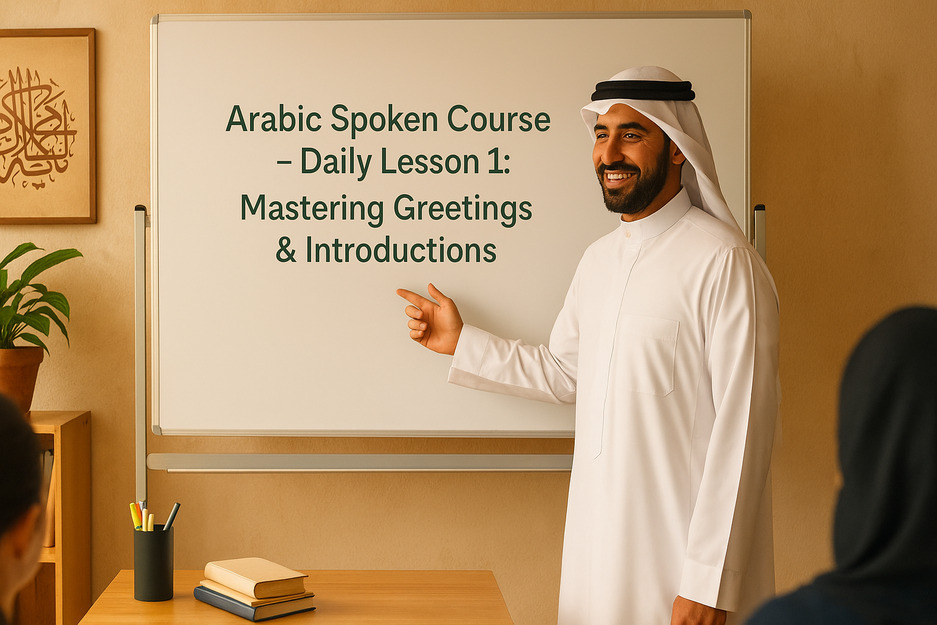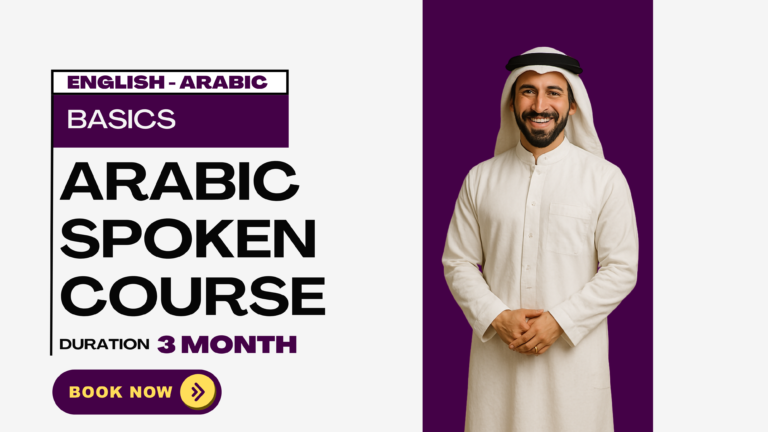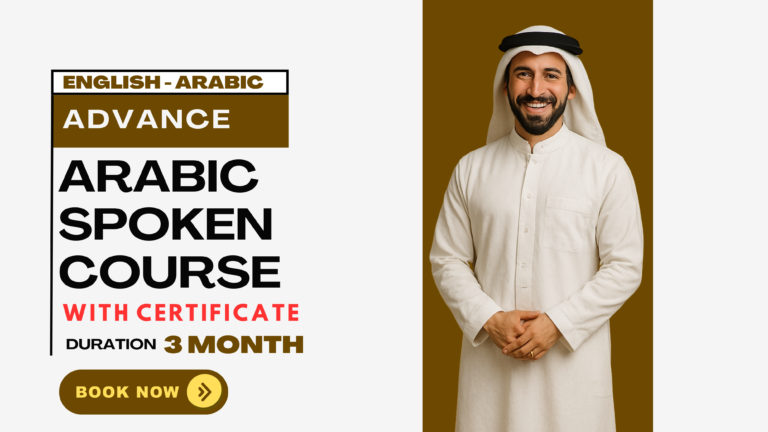Table of Contents
Toggle🌟 Introduction: Your First Step into Arabic Conversation
Imagine walking into a bustling market in Dubai or meeting a friendly taxi driver in Riyadh. The first thing you’ll need? A warm “السلام عليكم” (as-salaamu ʿalaykum) — Peace be upon you.
Welcome to Lesson 1 of our Arabic Spoken Course series! Whether you’re learning Arabic to travel, work, or connect with culture, this daily course is your guided path to fluency — starting today with Greetings and Introductions.
In this lesson, you’ll:
- Master basic Gulf Arabic greetings
- Practice simple introductions with clear translations
- Learn vocabulary with Arabic script, Romanization, and English
- Understand word-by-word sentence breakdowns
Let’s begin your journey with confidence and clarity.

🤝 Why Greetings Matter in Arabic Culture
In the Arab world, greetings are more than politeness—they’re a form of respect, warmth, and connection. You might hear a string of greetings in one encounter, especially in Gulf countries where hospitality is key.
Using the correct greeting can:
- Instantly build rapport
- Show cultural awareness
- Open doors for deeper conversations
📚 Essential Greetings in Gulf Arabic
Let’s look at commonly used greetings and their variations in the Gulf dialect (spoken in Saudi Arabia, UAE, Kuwait, Qatar, Bahrain, and Oman).
| Arabic Script | Roman Arabic | English Translation | Gulf Dialect Notes |
|---|---|---|---|
| السلام عليكم | as-salaamu ʿalaykum | Peace be upon you | Most common formal greeting |
| وعليكم السلام | wa ʿalaykum as-salaam | And peace be upon you | Common reply |
| مرحباً | marḥaban | Hello / Welcome | Formal; also used in writing |
| هلا | hala | Hi | Very common Gulf informal greeting |
| أهلاً وسهلاً | ahlan wa sahlan | Welcome | Polite and warm |
| صباح الخير | ṣabāḥ al-khayr | Good morning | Formal and friendly |
| صباح النور | ṣabāḥ an-nūr | Morning of light (reply) | Beautiful, poetic response |
| مساء الخير | masā’ al-khayr | Good evening | Used in social settings |
| مساء النور | masā’ an-nūr | Evening of light | Elegant reply |
👉 Tip: Gulf Arabs often say “هلا والله” (hala wallah), meaning “Hi by God!”—a warm, casual way to greet friends.
🧑🤝🧑 Introducing Yourself in Arabic (Gulf Dialect Style)
After greeting someone, the next step is to introduce yourself. Gulf Arabic keeps it simple, warm, and respectful.
💬 Conversation Example: Basic Introduction
In Arabic Script:
السلام عليكم
وعليكم السلام
شلونك؟
زين، الحمد لله. شسمك؟
اسمي خالد. وإنت؟
أنا سارة. تشرفت فيك.
In Roman Arabic:
As-salaamu ʿalaykum
Wa ʿalaykum as-salaam
Shlonak?
Zayn, al-ḥamdu lillāh. Shismak?
Ismi Khalid. Winta?
Ana Sarah. Tasharraft fīk.
In English:
Peace be upon you
And peace be upon you
How are you?
Good, thank God. What’s your name?
My name is Khalid. And you?
I’m Sarah. Nice to meet you.
🧠 Word-by-Word Breakdown
Let’s break down a key part of the conversation:
Arabic Script: شسمك؟
Roman Arabic: Shismak?
English: What’s your name?
| Arabic Word | Romanization | Meaning |
|---|---|---|
| شـ | sh | Short for “what” (from “shinu” or “sh”) |
| اسمك | ismak | Your name (ism = name, -ak = your [m]) |
💡 In Gulf dialect, people often shorten standard phrases. “ما اسمك؟” becomes simply “شسمك؟”
🧾 Quick Vocabulary Recap
Here’s a handy table to help you review today’s new words:
| Arabic Script | Roman Arabic | English | Use |
|---|---|---|---|
| السلام | as-salaam | Peace | Part of greeting |
| عليكم | ʿalaykum | Upon you (plural/formal) | Used in greetings |
| شلونك؟ | shlonak? | How are you? | Gulf dialect, male |
| شلونچ؟ | shlonich? | How are you? | Gulf dialect, female |
| زين | zayn | Good | Informal response |
| الحمد لله | al-ḥamdu lillāh | Thank God | Common in responses |
| اسمي | ismi | My name is | For introductions |
| أنا | ana | I am | Used before names |
| تشرفت فيك | tasharraft fīk | Nice to meet you | Male version |
| تشرفت فيچ | tasharraft fīch | Nice to meet you | Female version |
🔎 Key Insights: Making It Stick
1. Focus on Sound, Not Spelling
Arabic pronunciation matters more than perfect grammar at this stage. Gulf dialect is casual, and locals appreciate effort over perfection.
2. Practice With Voice
Say the dialogues out loud. Record yourself. Gulf Arabic has rhythm—your tongue will adapt with repetition.
3. Use Greetings Daily
Even if you only know 3 phrases, use them! Try saying:
- “Hala!” when picking up a call
- “As-salaamu ʿalaykum” when entering a room
- “Zayn, al-ḥamdu lillāh” when someone asks how you’re doing
🎯 Pro Tip: Avoid These Mistakes
- Don’t overuse “Marḥaban” — it’s more formal and rarely used among friends.
- Avoid confusing “anta” (you, male) and “anti” (you, female) early on — stick to the Gulf versions like “shlonak” and “shlonich”.
- Don’t worry about perfect grammar now—focus on conversation flow.
📌 Visual Summary: Beginner Conversation Cheat Sheet
| Situation | Arabic (Script) | Roman Arabic | English |
|---|---|---|---|
| Greeting | السلام عليكم | as-salaamu ʿalaykum | Peace be upon you |
| Reply | وعليكم السلام | wa ʿalaykum as-salaam | And peace be upon you |
| How are you? (m) | شلونك؟ | shlonak? | How are you? |
| How are you? (f) | شلونچ؟ | shlonich? | How are you? |
| I’m good | زين | zayn | Good |
| Thank God | الحمد لله | al-ḥamdu lillāh | Thank God |
| What’s your name? | شسمك؟ | shismak? | What’s your name? |
| My name is… | اسمي… | ismi… | My name is… |
| Nice to meet you (m) | تشرفت فيك | tasharraft fīk | Pleased to meet you |
✅ Conclusion: You’ve Mastered Lesson 1!
Today, you took a meaningful first step in your Arabic Spoken Course. By learning how to greet and introduce yourself in Gulf Arabic, you’re now ready to start small conversations with locals.
This lesson wasn’t just about words—it was about confidence, cultural respect, and real-life use.
FAQs About Arabic Spoken Course
💬 Ready to Keep Learning?
Explore:
- 👉 [Arabic Spoken Course Daily Lesson 2: Asking Questions]
- 📘 [Buy our Arabic Spoken Course Ebook – Beginner to Fluent]
- 🗣️ [Join Our Live Arabic Spoken Classes with Gulf Dialect Practice]
Got questions or want to try your own introduction in Arabic?
Drop a comment below and let’s chat!








1 Comment
I wish to speak gulf Arabic in an easy way with pronunciation